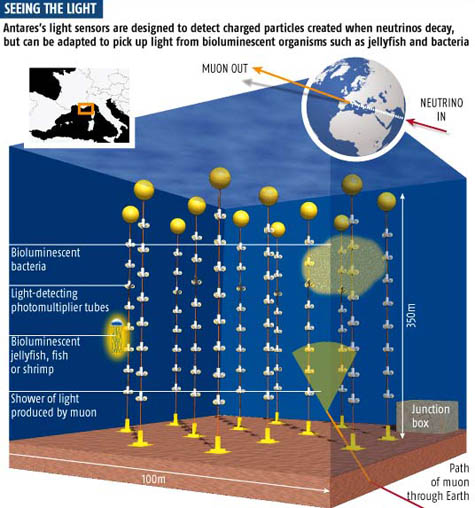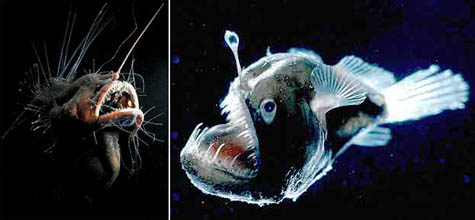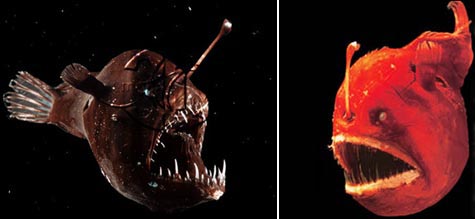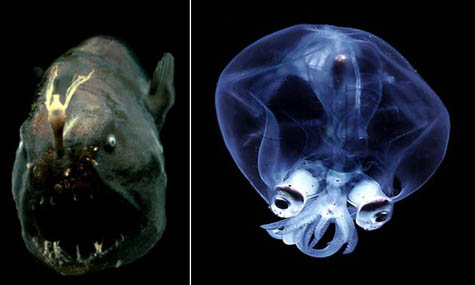- Spanning 10,000 square metres of the Mediterranean seabed, the Antares telescope is designed to tell us about the cosmos by picking up signs of elusive particles called neutrinos, which fly thousands of light years through space. To physicists' surprise, however, the underwater particle detector is also providing a unique glimpse of marine life.
 [Image: Courtesy of New Scientist].
[Image: Courtesy of New Scientist].The huge underwater mechanism – called Antares – will not only give us more "information about where [neutrinos have] originated, such as the outskirts of black holes," it will also register "waves of light" given off by "free-swimming bioluminescent bacteria" under intense benthic pressure at the bottom of the sea. Further, while peering into the outer dark, feeding currents of data into drone harddrives that think in slow algebras, unpeeling galaxial structure and calculating the future evolution of simulated stars, this machine amidst the shoals will also help solve "the mysteries of undersea storms."
Living clouds of light swim past, colliding with particles as old as the universe – and the drowned antenna whirs on, detecting all of it.
 Of course, all of this made me think of "From Beyond" by H.P. Lovecraft.
Of course, all of this made me think of "From Beyond" by H.P. Lovecraft. In "From Beyond," we encounter a narrator whose friend has 1) gone insane, 2) developed "baggy skin" with "hands tremulous and twitching," and 3) built a machine, complete with moving crowns of glass bulbs and "a powerful chemical battery," that will allow humans to "see and study whole worlds of matter, energy, and life which lie close at hand yet can never be detected with the senses we have."
 The man explains to our friendly narrator – who, for reasons of his own, has decided to visit this guy, overlooking his "repellent unkemptness" and "wild disorder of dress" – that:
The man explains to our friendly narrator – who, for reasons of his own, has decided to visit this guy, overlooking his "repellent unkemptness" and "wild disorder of dress" – that:- Within twenty-four hours that machine near the table will generate waves acting on unrecognized sense organs that exist in us as atrophied or rudimentary vestiges. Those waves will open up to us many vistas unknown to man and several unknown to anything we consider organic life. We shall see that at which dogs howl in the dark, and that at which cats prick up their ears after midnight. We shall see these things, and other things which no breathing creature has yet seen. We shall overleap time, space, and dimensions, and without bodily motion peer to the bottom of creation.
 Soon, the narrator shouts, there are "huge animate things brushing past me." These are "disgusting" and "indescribable shapes" like "jellyfish monstrosities" that "flabbily quive[r] in harmony with the vibrations from the machine."
Soon, the narrator shouts, there are "huge animate things brushing past me." These are "disgusting" and "indescribable shapes" like "jellyfish monstrosities" that "flabbily quive[r] in harmony with the vibrations from the machine." The living shapes are even "semi-fluid and capable of passing through one another and through what we know as solids."
Etc. etc. He ends up shooting the machine and his friend dies of apoplexy.
You can read the rest of the story here.
 So what happens when scientists fully assemble this vast and sprawling neutrino detector at the bottom of the Mediterranean Sea, within sight of ruined arches onshore and Piranesian streetscapes, only to find themselves detecting, in a chaos of vibration and flashing light, previously unknown and hostile forms of maritime life?
So what happens when scientists fully assemble this vast and sprawling neutrino detector at the bottom of the Mediterranean Sea, within sight of ruined arches onshore and Piranesian streetscapes, only to find themselves detecting, in a chaos of vibration and flashing light, previously unknown and hostile forms of maritime life? And what happens if that otherwise undiscovered life detects the machine?
Can BLDGBLOG retain the film rights?
No comments:
Post a Comment